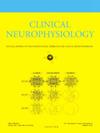The impact of Parkinson’s disease on adaptive split-belt walking: a muscle synergy analysis
IF 3.6
3区 医学
Q1 CLINICAL NEUROLOGY
引用次数: 0
Abstract
Objective
People with Parkinson’s disease (PwPD) face challenges in adapting their gait to asymmetrical demands, leading to turning abnormalities.
Methods
We investigated the neuromuscular control underlying these adaptive gait difficulties using muscle synergy analysis, including a novel statistical parametric mapping (SPM) approach. We compared 24 PwPD with 27 age-matched controls (HC) during asymmetrical split-belt (SB) and regular tied-belt (TB) walking.
Results
Both groups decreased from four to three synergies during TB- versus SB-walking. When only considering the transition back to TB-walking, PwPD were unable to increase their number of synergies as quickly as HC. Assuming four synergies, we compared synergy timing across treadmill phases and groups. We observed phase effects in both legs, but no group-by-phase interactions. The synergy encompassing the tibialis anterior showed abnormal activation in PwPD in the slow leg during SB-walking (post-hoc p < 0.001). Simplified neuromuscular control was related to worse adaptive performance in PwPD (r = -0.52,p = 0.009).
Conclusion
Although the number of synergies during adaptive walking was similar between groups, subtle within-synergy changes were apparent in PwPD.
Significance
This study is the first to examine the muscle synergies underlying adaptive SB-walking in PwPD, identifying impaired distal muscle activation as a potential fall risk factor in challenging gait situations.
帕金森病对适应性裂带行走的影响:肌肉协同分析
帕金森病(PwPD)患者在适应不对称需求的步态方面面临挑战,导致转向异常。方法利用肌肉协同分析,包括一种新的统计参数映射(SPM)方法,研究了这些适应性步态困难背后的神经肌肉控制。我们比较了24名PwPD与27名年龄匹配的对照组(HC)在不对称裂带(SB)和常规系带(TB)行走时的表现。结果两组在TB- vs - SB-walking期间的协同作用从4个减少到3个。当只考虑回到tb行走的过渡时,PwPD无法像HC那样快速地增加协同效应的数量。假设有四种协同作用,我们比较了跑步机阶段和组之间的协同时间。我们在两条腿上观察到相效应,但没有组与相的相互作用。包括胫骨前肌的协同作用在慢腿行走时显示PwPD异常激活(post-hoc p <;0.001)。简化神经肌肉控制与PwPD患者较差的适应表现有关(r = -0.52,p = 0.009)。结论虽然两组间在适应性行走过程中协同作用的数量相似,但在PwPD中协同作用发生了微妙的变化。这项研究首次研究了PwPD患者适应性sb行走的肌肉协同作用,确定了远端肌肉激活受损是挑战步态情况下跌倒的潜在危险因素。
本文章由计算机程序翻译,如有差异,请以英文原文为准。
求助全文
约1分钟内获得全文
求助全文
来源期刊

Clinical Neurophysiology
医学-临床神经学
CiteScore
8.70
自引率
6.40%
发文量
932
审稿时长
59 days
期刊介绍:
As of January 1999, The journal Electroencephalography and Clinical Neurophysiology, and its two sections Electromyography and Motor Control and Evoked Potentials have amalgamated to become this journal - Clinical Neurophysiology.
Clinical Neurophysiology is the official journal of the International Federation of Clinical Neurophysiology, the Brazilian Society of Clinical Neurophysiology, the Czech Society of Clinical Neurophysiology, the Italian Clinical Neurophysiology Society and the International Society of Intraoperative Neurophysiology.The journal is dedicated to fostering research and disseminating information on all aspects of both normal and abnormal functioning of the nervous system. The key aim of the publication is to disseminate scholarly reports on the pathophysiology underlying diseases of the central and peripheral nervous system of human patients. Clinical trials that use neurophysiological measures to document change are encouraged, as are manuscripts reporting data on integrated neuroimaging of central nervous function including, but not limited to, functional MRI, MEG, EEG, PET and other neuroimaging modalities.
 求助内容:
求助内容: 应助结果提醒方式:
应助结果提醒方式:


